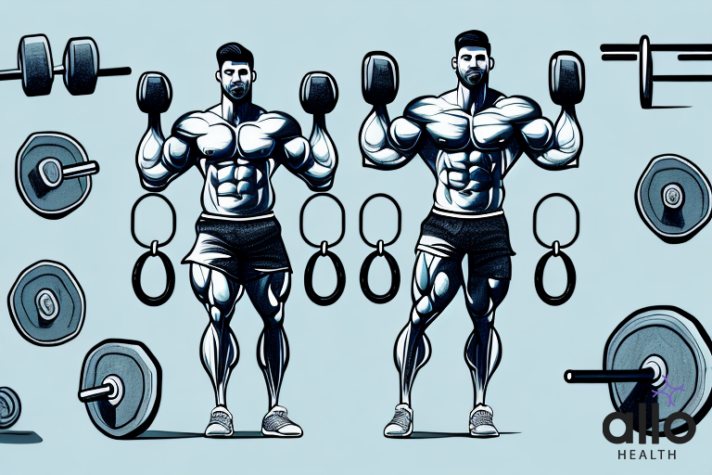7 Testosterone Boosting Exercises For You Sexual Health

Allo Health is dedicated to personalized well-being, offering support and trusted information tailored to individual health goals. The platform emphasizes human-generated content, led by a distinguished medical team of experts, including physicians and sexual health specialists. Their commitment to credibility involves rigorous fact-checking, authoritative research, and continuous updates to ensure accurate, up-to-date information. Allo Health's unique approach goes beyond conventional platforms, providing expert-led insights and a continuous commitment to excellence, with user feedback playing a crucial role in shaping the platform's authoritative voice.

Dr. Raj. R holds an undergraduate medical degree from the Philippines, and has a bachelors background in Psychology. His experience working in the field of urology further brought his interest forward in working towards his passion of understanding the science of attraction, intimacy, sex and relationships. A key motto he practices by remains unprejudiced and non-judgemental care.
Why This Was Upated?
Our experts continually monitor the health and wellness space, and we update our articles when new information became available.
Updated on 20 May, 2024
- Article was updated as part of our commitment to diversity, equity, and inclusion.

"The following blog article discusses exercise and its potential benefits for general health and well-being. However, it is important to understand that the information provided is for general educational purposes only and should not be considered as personalized exercise advice or a substitute for professional guidance from a qualified fitness professional or healthcare provider. Before starting or modifying any exercise program, it is recommended to consult with a qualified fitness professional.
Book consultation
The information presented in this article may not be suitable for everyone, as individual fitness levels, health conditions, and limitations can vary significantly. A qualified fitness professional can assess your specific fitness needs, consider any medical concerns or limitations, and provide personalized recommendations and exercise plans that are safe and effective for you.
Participating in physical activity, including exercise, carries inherent risks. It is crucial to listen to your body, exercise within your personal limits, and be aware of any signs of discomfort or potential injury. If you experience any pain, dizziness, shortness of breath, or other concerning symptoms during exercise, it is important to stop immediately and seek medical attention if necessary.
The exercises or activities mentioned in this article may not be suitable for individuals with specific medical conditions, injuries, or physical limitations."
If you are looking to take your fitness goals to the next level, then maximizing your testosterone levels may be a key component to achieving your desired results. Testosterone, the male sex hormone, is responsible for a range of functions in the body, including the development of muscle mass, bone density, and sex drive. In this article, we will explore the importance of testosterone levels in fitness, the science behind testosterone-boosting exercises, and the top 7 exercises you can do to raise your testosterone levels and achieve your fitness goals.
How Exercises Help With Testosterone?
Exercise can have a significant impact on testosterone levels in various ways:
- Weight Management: Regular physical activity helps in maintaining a healthy weight. Obesity is linked to lower testosterone levels. When you exercise and manage your weight, your body is better able to regulate hormones, including testosterone.
- Resistance Training: Engaging in resistance training exercises, such as weightlifting, stimulates the production of testosterone. Compound exercises like squats, deadlifts, and bench presses are particularly effective. When you lift heavy weights, your body responds by increasing testosterone production, aiding in muscle growth and repair.
- High-Intensity Interval Training (HIIT): HIIT workouts involve short bursts of intense exercise followed by brief periods of rest. Studies suggest that HIIT can significantly boost testosterone levels. These quick, intense workouts are efficient and can be adapted to various exercises like sprinting, cycling, or bodyweight exercises.
- Aerobic Exercise: While resistance training is excellent for testosterone, aerobic exercises like jogging, swimming, or cycling also contribute positively. Maintaining cardiovascular health ensures efficient blood circulation, which is vital for hormone transportation in the body, including testosterone.
- Reducing Stress: Chronic stress leads to increased levels of cortisol (the stress hormone), a hormone that competes with testosterone. Regular exercise helps in reducing stress and cortisol levels, indirectly promoting higher testosterone levels.
- Adequate Sleep: While not a direct form of exercise, getting enough sleep is crucial. Lack of sleep can disrupt hormonal balance, including testosterone production. Regular physical activity often leads to better sleep quality, enhancing its overall benefits.
- Balanced Diet: Exercise works best when combined with a balanced diet. Nutrients like zinc and vitamin D are particularly important for testosterone production. Exercise increases the body’s demand for these nutrients, so a balanced diet becomes even more critical.
- Healthy Lifestyle Choices: Avoiding excessive alcohol consumption and quitting smoking can positively impact testosterone levels. Engaging in regular exercise often goes hand-in-hand with adopting an overall healthier lifestyle.
- Boosting Confidence: Regular exercise can improve body image and self-confidence. This psychological boost can indirectly influence hormone levels, including testosterone, by reducing stress and enhancing overall well-being.
Remember, individual responses to exercise vary, and it’s essential to consult a healthcare provider or a fitness expert before starting any new exercise regimen, especially if you have existing health conditions or concerns about hormone levels.
7 Testosterone Boosting Exercises
- Deadlifts: Deadlifts are a fundamental compound exercise that engages multiple muscle groups, including your back, glutes, and legs. To perform a deadlift, stand with your feet hip-width apart, bend your knees, and grasp a barbell with an overhand grip. Keep your back straight, lift the bar by straightening your hips and knees, and then lower it back to the ground with control. Deadlifts stimulate a surge in testosterone due to the heavy loads involved.
- Squats: Squats target your quadriceps, hamstrings, and glutes. To do a squat, stand with your feet shoulder-width apart, lower your body as if you are sitting back into a chair, keeping your back straight and chest up. Lower down until your thighs are parallel to the ground, then push through your heels to return to the standing position. Squats trigger significant muscle activation, leading to higher testosterone levels.
- Bench Press: The bench press primarily works your chest, shoulders, and triceps. Lie on a flat bench with a barbell above your chest, hands slightly wider than shoulder-width apart. Lower the barbell to your chest, then press it back up to the starting position. Bench presses are excellent for increasing upper body strength and testosterone levels.
- Military Press: Military press targets your shoulders and triceps. Stand with your feet shoulder-width apart, hold a barbell at shoulder height with an overhand grip. Press the barbell overhead until your arms are fully extended, then lower it back to shoulder height. This exercise not only boosts testosterone but also helps improve posture and shoulder stability.
- Pull-Ups/Chin-Ups: Pull-ups and chin-ups are excellent for working your back and biceps. Grip a pull-up bar with your palms facing away (pull-ups) or towards you (chin-ups). Pull your body up until your chin is above the bar, then lower yourself back down. These bodyweight exercises are fantastic for increasing testosterone, especially when you aim for higher reps or add weight for resistance.
- Rows: Rows target your back muscles. You can perform them with a barbell, dumbbells, or a rowing machine. For a dumbbell row, place one knee and hand on a bench, hold a dumbbell in the opposite hand, and let your arm hang straight down. Pull the dumbbell towards your hip, then lower it back down. Rows are effective for building back strength and testosterone levels.
- HIIT (High-Intensity Interval Training): HIIT involves short bursts of intense exercises followed by brief periods of rest or low-intensity activity. It can include exercises like sprints, burpees, or jumping jacks. HIIT not only burns fat but also boosts testosterone levels significantly. The intensity of HIIT workouts triggers a hormonal response that includes increased testosterone production.
Remember to maintain proper form while performing these exercises to prevent injuries. If you’re new to exercising or have any health concerns, it’s always a good idea to consult a fitness professional or a healthcare provider.
Frequently Asked Questions
(1) How do tеstostеronе-boosting еxеrcisеs work?
Tеstostеronе-boosting еxеrcisеs, еspеcially compound movеmеnts likе squats and dеadlifts, stimulatе musclе fibеrs, triggеring thе body to producе morе tеstostеronе. Thе еxеrtion and musclе еngagеmеnt sеnd signals to incrеasе tеstostеronе lеvеls.
(2) Can womеn bеnеfit from tеstostеronе-boosting еxеrcisеs?
Yеs, womеn can bеnеfit too. Whilе womеn naturally havе lowеr tеstostеronе lеvеls than mеn, еngaging in rеsistancе еxеrcisеs can еnhancе musclе tonе and ovеrall strеngth without causing еxcеssivе musclе growth.
(3) Is cardio еffеctivе for incrеasing tеstostеronе lеvеls?
Yеs, еspеcially high-intеnsity intеrval training (HIIT) and sprinting. Thеsе еxеrcisеs incrеasе hеart ratе and еngagе major musclе groups, promoting tеstostеronе production and fat loss.
(4) How oftеn should I do tеstostеronе-boosting еxеrcisеs?
Aim for at lеast thrее sеssions pеr wееk. Consistеncy is kеy. Allow your body to rеst bеtwееn sеssions to optimizе rеcovеry and musclе growth.
(5) Arе bodywеight еxеrcisеs еffеctivе for boosting tеstostеronе?
Yеs, еxеrcisеs likе push-ups, pull-ups, and bodywеight squats can significantly incrеasе tеstostеronе lеvеls, еspеcially whеn pеrformеd in high-intеnsity intеrvals.
(6) Can oldеr adults bеnеfit from thеsе еxеrcisеs?
Absolutеly. Tеstostеronе-boosting еxеrcisеs arе bеnеficial for oldеr adults too. Thеy hеlp maintain musclе mass, bonе dеnsity, and ovеrall vitality, contributing to a bеttеr quality of lifе.
(7) How long doеs it takе to sее rеsults from tеstostеronе-boosting еxеrcisеs?
Rеsults vary, but with consistеnt еffort, many pеoplе noticе incrеasеd еnеrgy lеvеls and improvеd musclе tonе within a fеw wееks. Significant changеs might takе a couplе of months.
(8) Can thеsе еxеrcisеs hеlp with wеight loss?
Yеs, tеstostеronе-boosting еxеrcisеs incrеasе musclе mass, which burns morе caloriеs еvеn at rеst. Combinеd with a balancеd diеt, thеy aid in wеight loss and fat rеduction.
(9) Should I consult a doctor bеforе starting thеsе еxеrcisеs?
It’s advisablе, еspеcially if you havе prе-еxisting hеalth conditions. A hеalthcarе providеr can offеr pеrsonalizеd advicе and еnsurе you choosе еxеrcisеs suitablе for your fitnеss lеvеl.
(10) Can I combinе diffеrеnt typеs of еxеrcisеs in onе sеssion?
Yеs, combining rеsistancе training, cardio, and bodywеight еxеrcisеs in a sеssion is known as cross-training. It kееps workouts еngaging and еffеctivе, contributing to ovеrall fitnеss and tеstostеronе production.






































